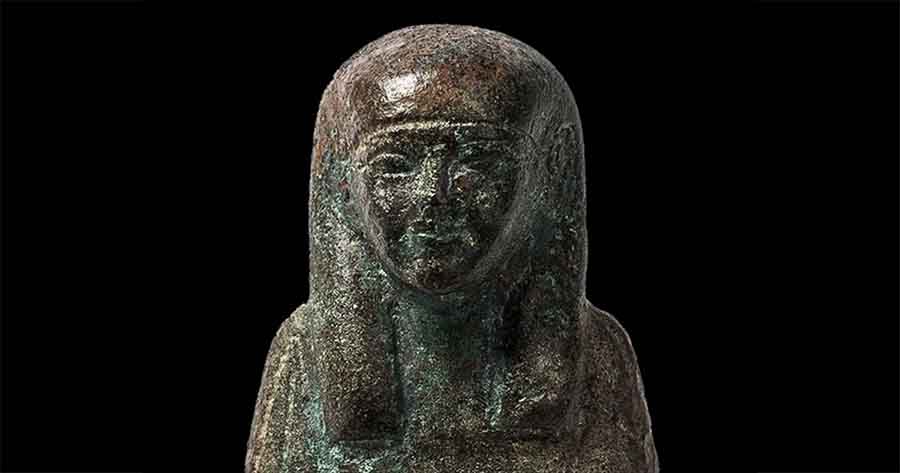Study of Ushabti Copper Origins Enlightens Egypt’s Dark Age
While many archaeologists focus on the symbolic meaning of recovered temple treasures and grave goods, others concentrate on their origin stories. In this case a team of scientists have used high technology to peer into the microscopic fabric of four tomb figurines called ushabtis , and the results have revealed volumes about ancient trade routes through Egypt’s Third Intermediate Period, which was blighted with socio-political upheaval.
Studying the Cooper Content of Four Afterlife Workers
Dr. Shirly Ben-Dor Evian, a curator of Egyptian archaeology at the Israel Museum in Jerusalem, has published a new study in the Journal of Archaeological Science, looking at the source of ancient Egypt ’s copper during a time the country was split in two politically. Lead isotope analysis was performed on samples taken from four bronze funerary “ushabtis,” recovered from Tanis, the Pharaoh’s capital, that were created in the reign of Psusennes Ibetween 1056 to 1010 BC.

Ushabti of Pharaoh Psusennes I (XXI Dynasty, second half of the XI century BC). (Ben-Dor Evian et al. / Journal of Archaeological Science: Reports, 2021)
Ushabtis are most commonly found in tombs and graves in ancient Egypt and they represent mummified human figures, usually with their arms crossed over their chest. Egyptologists think these artifacts were included in burial rituals because the Egyptians believed they would reanimate in the afterlife, where they worked for the deceased, essentially streamlining the course of the traveling soul. The study explains how the copper that was used to make these four grave figurines had been sourced from the Arabah region, to the south of what is today Israel.
- Pharaoh’s Little Helpers: The Shabti Funerary Statuettes of the Ancient Egyptians
- Psusennes, the Silver Pharaoh with riches that rivalled those of Tutankhamun
This new information serves as hard proof that the Egyptian civilization survived, and prospered, during the Third Intermediate Period from 1070 BC to 664 BC, about which little is understood.

Ushabti of Queen Mutnejemet, wife of Pharaoh Psusennes I. (Ben-Dor Evian et al. / Journal of Archaeological Science: Reports, 2021)
Flourishing Metal Arts and Twisted Political Environments
Finding copper had been imported from much further north during this period indicated to Dr. Ben-Dor Evian the existence of “an exchange network between the Egyptians and the Arabah region that continued to operate, even as other nearby empires were collapsing around Egypt.” Working with researchers from Tel Aviv University and Geological Survey of Israel, Ben-Dor Evian told ARTnews that the new research shows “despite internal strife within Egypt and the decline of the empires in the ancient near east, Egypt continued to play a significant role in the region.” Furthermore, also dating back to the Third Intermediate Period, Dr. Ben-Dor Evian identified materials from the Timnaand Feynan copper mines in southern Israel.
- King Solomon’s Mines Discovered: Kings and Pharaohs - Part I
- Three Famous Sites in One – The Story of the Legendary City of Tanis
Compared with the previous two, the Third Intermediate Period was a time of considerable political strife in Egypt. Rivalry had created a schism leading to Lower Egypt being run by Pharaoh Psusennes I while a powerful high priest controlled Upper Egypt, and the northern trade routes. However, the copper discovered in the ushabtis inferred to the team of researchers that Psusennes was still able to import copper from the copper mines in Arabah.

Archaeologists excavating at the copper mines of Timna in the Aravah Valley. (Ariel David)
A Speck of Copper Can Change a Lot…
The new study not only points out that copper was being imported from the north in the Third Intermediate Period, but it also suggests metal arts may have “flourished” during this time. It is known that after Pharaoh Psusennes, his predecessor Sheshonq I invaded Arabah, and this new information means Egyptologists must now be consider that the ‘primary’ reason for this military campaign might have been to control the valuable northern copper trade routes.
The ramifications of finding northern sourced copper in Lower Egypt during the Third Intermediate Period will be fascinating to see roll out. But for now, this new study goes a long way to changing the traditional perception that Egypt had become an isolated state during the Third Intermediate Period. All because the copper discovered in four afterlife workers (ushabtis) proved the existence of northern trade routes predating Sheshonq I’s reign.
Top Image: Researchers analyzed copper found in ushabtis from the understudied Third Intermediate Period. Source: Shirly Ben-Dor Evian et al. / Journal of Archaeological Science: Reports, 2021
By Ashley Cowie

















